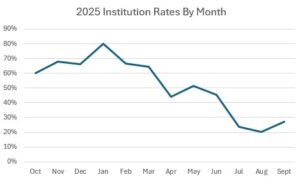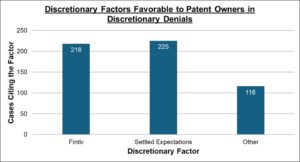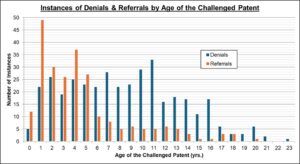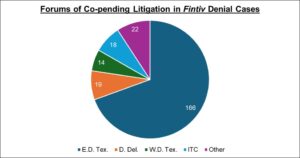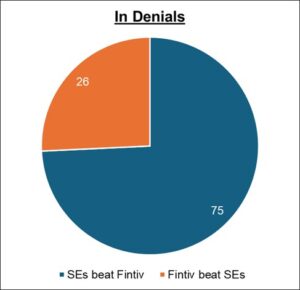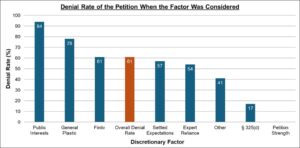By Adam J. Cook, Daniel C. Sloan, and Matt Johnson –
The October 17 Memo from Director Squires marked the end of a distinct discretionary denial era, the Interim Era. Per the memo, as of October 20, all institution decisions (discretionary, non-discretionary, and merits-based) will be made by the Director in consultation with three PTAB judges. See our post here. There will no longer be separate discretionary and non-discretionary/merits-based decisions in each case; one institutional decision will be released per case deciding on all potential grounds for institution. Moreover, Vice Chief APJ Michael Kim explained that “summary notices will be the primary vehicle for the vast majority of cases” under the new regime. See our post here. Summary notices are simple thumbs-up or thumbs-down decisions on institution that contain no reasoning or analysis, which do not specify whether institution was denied based on discretionary factors or the merits.
With this post, Jones Day caps its statistical analysis of every discretionary denial decision published during the Interim Era (cases affected by Deputy Director Coke Morgan Stewart’s March 26, 2025 Interim Memo to Director Squires’s October Memo). These decisions were released from May 16, 2025 to October 17, 2025. The affected petitions were filed as far back as November 8, 2024 and as recently as June 24, 2025.
The USPTO analyzed 620 cases during the Interim Era. The discretionary denial rate was 61%.
Overall institution rates, as reflected in the FY2025 final statistics, hit a five-year low of 50% in the USPTO’s fiscal year 2025 due in part to the high discretionary denial rate during the Interim Era.
The monthly institution rates show a sharp decline in trial institutions over the last three months of FY2025, with July-September institution rates being 24%, 20%, and 27%, respectively.
Certain factors favored patent owners in denials more often than others, with settled expectations and Fintiv leading.
Fifty-eight percent (218/377) of denials were based on Fintiv. The settled expectations of the patent owner favored denial in 60% (225/377) of denials. Meanwhile, § 325(d) (whether the same or similar prior art or arguments were previously presented) weighed against the petitioner in 15 denials (4%). In 21 denials (6%), the Deputy Director explicitly found that there was no material error during prosecution. An additional factor that commonly favors denial, when applicable, is whether the patent was (or is being) challenged in prior (or ongoing) proceedings, such as district court litigations, IPRs, or ex parte reexaminations.
Similar trends regarding settled expectations and Fintiv can be seen with factors favoring petitioners in referrals. In these cases, “other” factors such as the strength of the petition, complex and diverse underlying litigations, and material error during prosecution also often influenced whether a petition survived to the merits stage.
Below is an updated version of the graph from the previous statistical update, which displays instances of denial and referral based on the age of the challenged patent for all 620 cases. The age of the challenged patent is a key factor in every settled expectations analysis.
The forum of co-pending litigation affected the outcome of the Fintiv factors in many cases. Quicker filing-to-trial jurisdictions, such as the Eastern District of Texas and the ITC saw the most instances of Fintiv denials.
When Fintiv and settled expectations went head-to-head, settled expectations often won in referrals and denials.
Overall denial rates of petitions when a factor was explicitly considered are charted below.
Data Collection Methodology:
Data was obtained by searching Docket Navigator and the USPTO’s public docket. Cases were classified by discretionary factors explicitly considered and the party those factors favored. A factor is “explicitly considered” when it is either (i) mentioned by name in the decision (e.g., the decision mentions “the settled expectations of the parties”) or (ii) it is alluded to as a considered factor (e.g., the decision considers the age of the patent without mentioning “the settled expectations of the parties” by name). To determine which factors the decisionmaker is addressing when it is unclear on the face of the decision, the parties’ briefs were analyzed. For this post, a factor favors a particular party when the decision states (i) the factor weighs in favor of or against discretionary denial or (ii) the factor does not tip the balance for or against discretionary denial. For the latter category, the factor was classified as favoring the party opposed to the failed argument.
Matthew Johnson
Latest posts by Matthew Johnson (see all)
- Discretionary Decision Statistics Update - November 4, 2025
- PTAB Issues First Summary Institution (Denial) Decisions - November 3, 2025
- PTAB Presentation Regarding Director Institution – Slides and Rough Transcript - October 30, 2025




